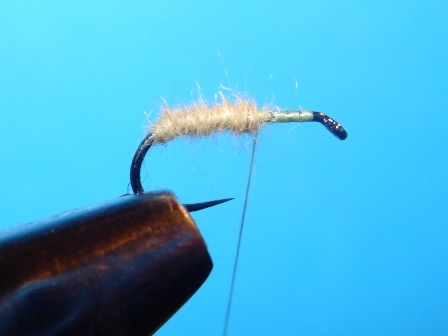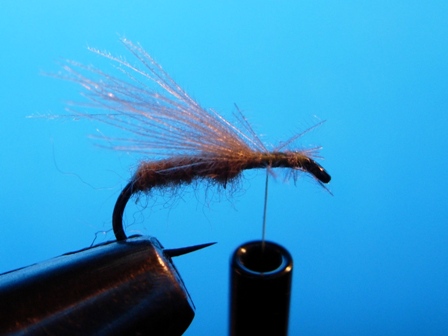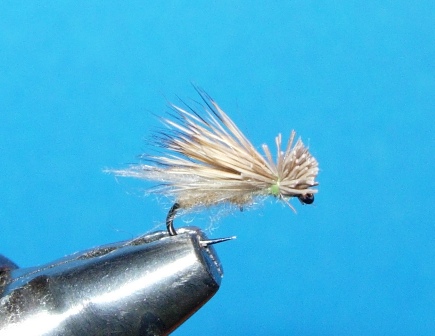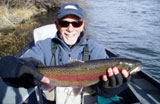Description
If you’ve spent a lot of time prowling
around trout streams, you’ll have noticed
frustratingly tiny caddis adults bouncing
about, particularly in the evenings—and I do
mean T-I-N-Y, as in size 20 or smaller (down
to 24). Here’s what noted entomologist Rick
Haefle has to say about these miniscule
beasts: “Adult emergence can begin as early
as June for a number of species, but peak
activity generally occurs in July and August
with many species continuing hatch activity
into September. Because of their small size
emergence activity goes unnoticed by most
anglers. The best place to spot adults is on
shoreline vegetation or boulders, where they
run and flit with a nervous energy. When
adults are observed along the stream and
fish seem to be rising to some mysterious,
unseen surface food, start thinking
micro-caddis patterns.
“The time of day emergence and egg laying
activity takes place is not well documented
for most species. In general mid-afternoon
to evening is the best time to look for them
on the water and available to fish. I have
found it difficult to tell if fish are
taking pupae rising to the surface or adults
returning to lay eggs. In such cases I first
try a pupa pattern. If that doesn’t work, I
then put on an adult pattern. The type of
water one fishes for pupae or adults is the
same; moderate riffles and runs or the slow
gentle currents of weedy flats.” (See Rick’s
full article at
http://www.laughingrivers.com/rick-microcaddis.html)
Maybe because I’m contrarian by nature, I
tend to fish tiny nymphs and pupae patterns
during the hatch. If I don’t catch fish on
these, then I’ll switch to an adult pattern.
My go-to selection is what I call the
“Micro-Caddis Fuzzball”. The name refers to
its appearance on the water, at least to
those of us who are a bit challenged in the
distance vision category. The fly’s design
is all about being able to see
it—something—out there on the water. I’ll
tie them as small as 22, but that’s where I
draw the line (mainly because my tired eyes
have a hard time focusing on anything
smaller), using short shank scud-type light
wire hooks because they have an increased
gape for hooking purposes. Obviously one
doesn’t get much material on a hook of that
size—but that’s a good thing, because when
tying small, the tyer must think “sparse,
sparse, sparse.” In the “tips” section below
I’ll provide some suggestions for improving
your small-fly tying prowess. For now, let’s
tackle a Fuzzball, using a size 20 hook.
Tying Instructions
(Note: click Ctrl+ about 6 times to
enlarge the webpage & see photo
detail; Ctrl– 6 times to reduce
size)
|
|
1. De-barb the hook, and cover the shank
down to mid-bend with a single layer of
thread. This is important in order to
achieve a nice smooth tapered abdomen. Ugly
underbody, ugly body—that’s the watchword.
2. Dub a sparse, tapered abdomen, leaving
the front third of the hook open.
|

|
|
|
|
|
3. Lay two CDC feathers on the tying bench
and place one over the top of the other,
taking care that their curvature matches.
Cut the hearts out of the two feathers and
bunch up the tips.
4. At the front of the abdomen, tie in the
bunched up CDC tips as an under-wing. The
under-wing’s length should not extend beyond
the bend of the hook. |
 |
|
|
|
|
5. Cut and thoroughly clean a small bunch of
deer hair, and place the hair into a hair
stacker to even up the tips. Measure the
hair to the length of the under-wing and
clip the butts, leaving a 1/16” butt
remaining.
6. Tie in the deer hair wing just ahead of
the CDC under-wing; don’t crowd the head as
it will make finishing the fly very
difficult. Be sure that the hair stays
directly on top of the hook.
7. Once the deer hair wing is secure, push
the butts upward and to the rear; this will
create a nice head profile. Whip finish
directly in front of the butts, and
carefully place a tiny drop of super glue on
the bottom of the head.
|
 |
|
|
|
|
Tying
& Fishing Tips
1. It is much easier to de-barb the hook at
the vise than on the stream. If you drop the
tiny hook at the bench you have a fighting
chance to find it; not so if you drop your
fly while on the stream either when you are
trying to extract it from the fly box or
while tying it on.
2. When dubbing the Fuzzball,
use the tiniest pinch of dubbing that you can pull out. A good rule of thumb is
to tease out a tiny amount and then cut it in half.
3. After using super glue to
finish the fly, use a piece of fine copper wire to ream out the eye. It will be
hard enough to tie a Fuzzball to your leader, but you’ll become totally
frustrated if you discover the tiny eye clogged as you try to poke the leader
into the eye.
Accept my challenge to tie a
tiny critter; be patient and tie at least a half dozen and you’ll begin to get
the hang of tying small.
|
|
|
|
|
 |
|

